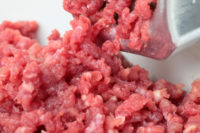Ingredients
Versatility, with health benefits
Gums, fibers and starches are low-cost alternatives to other non-meat ingredients, and work well as extenders.






It makes sense that consumers would rather read “carrot fibers” on an ingredient list than inorganic phosphates.
“Many meat processors are looking at gums, fibers and starches as a substitute for inorganic phosphates and as a way to reduce salt in their products,” says Lynn Knipe, Ph.D., extension processed meats specialist at The Ohio State University, based in Columbus, Ohio. “For either application, carrageenan, fibers and starches often typically work well on clean labels.”
Processors have been using extenders in animal proteins for years. Gums, fibers and starches are low-cost alternatives to other non-meat ingredients, and work well as extenders.
“Manufacturers of protein-based foods are increasingly reaching out to gums, fibers and starches for their functional properties in the processing of processed foods and for their health benefits such as satiety and lower glycemic indices,” says Kantha Shelke, founder and scientist, at Chicago-based Corvus Blue.
They can help reduce the blood glucose response to food intake, help with digestive health and weight management, besides stretching the formulation inexpensively.
“Of the fiber options — sugar beet, oat and carrot fibers — carrot fiber seems to work the best,” notes Knipe. “Another relatively new product to consider is rice bran. Of all of the potato starches that are available, I personally prefer potato starch for meat applications.”
Formulating health and wellness
Certainly, applications for gums, fibers and starches have changed the last few years in animal proteins, so that they now offer health-and-wellness benefits, such as delivering prebiotics, nutrition, satiety and appetite control, glycemic health or fiber applications.
“The health-and-wellness platform is alive and thriving amongst protein food manufacturers,” says Shelke.
While applications have not changed drastically in the last year, says Shelke, she points out that formulators are more discerning among this group of ingredients for the following reasons:
- Dietary fibers with good digestive tolerance but which do not change the taste or texture of protein foods.
- Gums that can help carry flavors and thereby, replace or reduce salt in the sauce, without creating any unpleasant flavors.
- Fibers and starches with proven benefits to human health, in particular digestive health and weight management, because not all fibers and starches help with satiety.
- Gums and starches that help reduce the blood glucose response to food intake.
- Commercially viable sources of soluble dietary fiber that are stable at a low pH and demonstrate good digestive tolerance.
- Gums — as fat mimetic and fat replacement or bulking agents — to help lower calories that would otherwise come from fat.
Selecting the right fiber
Different types of fiber — insoluble and/or soluble — can be added to food formulas, but selecting the right type of fiber is critical to the success of the finished product with consumers, says Shelke.
“The biggest challenge for product developers is figuring out which fiber to select from the commercially available fibers: sugar cane fiber, powdered cellulose, white wheat fiber, bamboo fiber, oat fiber, pea fiber, cottonseed fiber, sugar beet fiber, psyllium fiber and potato fiber,” says Shelke. “The choice depends on the formulators’ specific criteria, and of course, the product and process criteria.”
Fiber and starches can change the product formulation parameters, particularly the amount of water added to the formulation and how much will be taken up by the fiber or the starch.
“But, these ingredients can also change the mouthfeel of the finished product, and it requires trial and error and a lot of skill to identify the correct particle size and type of fiber so the finished product does not end up tasting like cardboard,” she says.
Another challenge with fibers and starches is that the usage levels of these ingredients are self-limiting, says Shelke.
“So one can only go so far with each of the ingredients and has to be especially skillful in finding the right mix of other ingredients to optimize their functionalities,” she says. In addition, gums can be tricky to manipulate.
“Gums can often, as their name suggests, be gummy — a texture that is disliked by most consumers,” says Shelke. “Formulating with gums requires plasticizing or cutting in with other ingredients to help modulate the sliminess or gumminess of the finished product texture.”
To counteract these limitations, formulators are turning to sophisticated statistical methods like response surface methodology to help identify the right combination of ingredients to enhance their particular foods.
They are also using “trained sensory panelists to ensure that their foods are appealing not only on the day they are produced, but also after extensive storage, distribution and temperature abuse to mimic the conditions that some products go through before they reach their end consumer,” says Shelke.
Looking for a reprint of this article?
From high-res PDFs to custom plaques, order your copy today!










